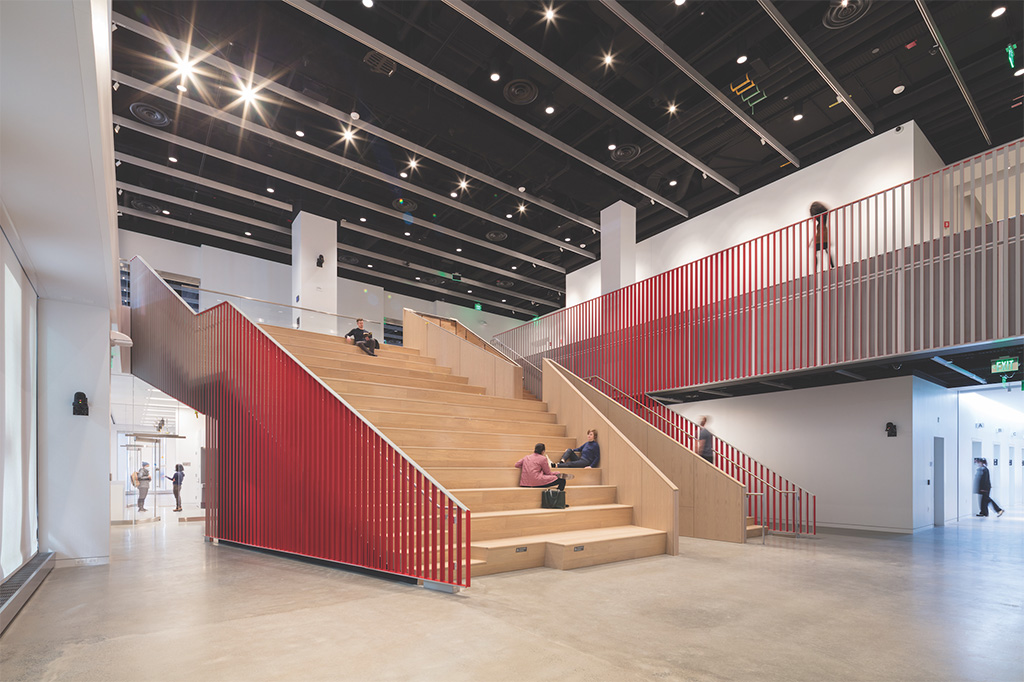MIT Museum prepares for reopening in Kendall, going straight into reimagined Science Festival

The new MIT Museum is ready to open in Kendall Square with an “Essential MIT” exhibition. (Photo: Anna Olivella)
The MIT Museum reopens Oct. 2 after a Covid lockdown that merged into an expected shutdown to relocate to a new home on the East Campus, a showpiece Kendall Square location at 314 Main St.
The first glimpse of the new three-floor, eight-gallery space will be Sept. 23 for the MIT community, followed by a Cambridge Community Day on Oct. 1 to provide a peek to residents, the school said Thursday. For most, it will be the first access since the coronavirus closed public buildings in March 2020; early in the pandemic, expected to be open for visits last year.
The museum opens daily starting Oct. 2 from 10 a.m. to 5 p.m., leading directly into a reimagined Cambridge Science Festival of opening programming from Oct. 3-9. The festival, which the museum founded in 2007, is a week of events, demonstrations, workshops and performances that this year includes the free “Borealis,” Swiss artist Dan Acher’s rendering of the northern-sky phenomena, an Oct. 8 merger with Boston Fashion Week; and a final day science-themed, robot-heavy Great American Carnival with a main stage, midway, sideshows and walk-abouts.
When all the opening ado is done, museum leaders note that residents can sign up for free general admission year-round.

The “Borealis” art installation will run over four days during the Cambridge Science Festival in October. (Photo: David Solm/Novatech)
“The opening of the MIT Museum completes the trio of spaces – including the Welcome Center and the two acres of community green space – that make up the heart of the gateway to our campus,” MIT provost Cynthia Barnhart said in a press release.
The news comes soon after the school’s announcement it won’t undo the bulk of its Covid-era closed campus. Buildings that have traditionally been open to anyone will require MIT identification or other official permission to access indefinitely. It’s a move at odds with the mission of museum director John Durant.
“The MIT Museum is consciously standing at the interface between a world-famous research institute and the wider world. We plan to ’turn MIT inside out’ by making what MIT does visible and accessible to all. Visitors will see that we are focused on the question: what does all this intensive creativity, research, innovation, teaching and learning mean – not least, for the wider community of which we’re all part?” Durant said.

The Exchange at the new MIT Museum. (Photo: John Horner/Höweler + Yoon Architecture)
In July, before the school’s closed-campus ruling, he told its news service that “Our job as a museum is to make what MIT does, both the processes and the products, accessible … MIT can sometimes seem like a rather austere place. It may be seen as the kind of a place where only those super-smart people go to do super-smart things. We don’t want to send that message. We’re an open campus, and we want to send a message to people that whoever they are, from whatever background, whatever part of the community, whatever language they speak, wherever they live, they have a warm welcome with us.”
Despite the new restrictions, the museum is expected to invite visitors to “take part in ongoing research” and show how science and innovation shapes the future of society, leaders said. “The new MIT Museum is planned as a place where you can really learn something new. The exhibits present high-level research in a way that is interactive and meets visitors where they are, whether they are entirely new to science or already experts,” said Phillip A. Sharp, MIT Institute professor and chair of the MIT Museum Advisory Board.
The museum includes freshly conceived exhibitions featuring objects from a collections of more than 1 million objects, along with loans of art and artifacts, in eight galleries that “spiral up the building, and that travel from the local to the global and back again,” Durant said. There’s an Exchange event and meeting space for public dialogue and conversation; and a hands-on Maker Hub, where audiences can experiment with putting scientific ideas into action.
Opening exhibits allow visitors to write poetry with an artificial intelligence in one room while considering the impact of AI on the future of work nearby, according to descriptions released Thursday. The galleries include a prototype of Nobel winner Rainer Weiss’ Laser Interferometer Gravitational-wave Observatory, which proved Einstein’s theory of relativity; the NASA-MIT Starshade Rendezvous Mission star-shade petal designed by Sara Seager to allow photography of exoplanets; the 1892 diploma of pioneering architect and professor Robert Robinson Taylor, the first Black graduate of MIT; the Apollo Guidance Computer (Block II), critical to the success of Apollo missions; and selected photography.
The 56,000-square-foot designed by Höweler + Yoon Architecture is significantly bigger than the 12,600-square-feet previous site at 265 Massachusetts Ave., which MIT said in 2019 was earmarked for lab space. “The building is unique, with a very large footprint, and lends itself to research purposes,” said Sarah Gallop, co-director at the Office of Government and Community Relations at MIT. “There’s been no thinking beyond that.”
![]()

Yoltar-Yıldırım
In other museum news, Ayşin Yoltar-Yıldırım is joiniing the Harvard Art Museums as Norma Jean Calderwood Curator of Islamic and Later Indian Art effective Oct. 3, according to an announcement Thursday by Martha Tedeschi, the Elizabeth and John Moors Cabot director of the Harvard Art Museums. Ayşin returns to the Harvard Art Museums after having served as assistant curator for Islamic and later Indian art from 2013 to 2017, and before that, the 2011-2013 Norma Jean Calderwood Curatorial fellow. She’s now the Hagop Kevorkian associate curator of Islamic art at the Brooklyn Museum in New York.



